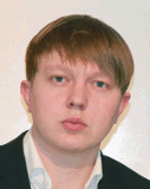 |
|
Biography
Alexander Makarov was born in Volgograd, Russia, in 1985. He studied information technology at the Volgograd State Technical University, where he received the BSc degree in 2006 and MSc degree in 2008. He joined the Institute for Microelectronics in October 2009 and has obtained the doctoral degree in March 2014. He is currently employed as a post-doc researcher. His scientific interests include Monte-Carlo simulations and nonvolatile memory device modeling.
Structure Optimization of a Bias-Field-Free Spin-Torque Oscillator Based on Two MgO-MTJs
New types of spintronic devices utilizing all-electrical magnetization manipulation by current, such as spin-torque transfer RAM and spin-torque oscillators, have been developed based on MgO Magnetic Tunnel Junctions (MTJs) with a large magneto-resistance ratio. Spin-torque oscillators based on a single MTJ with in-plane magnetization show high frequency capabilities, but still need an external biasing magnetic field and are characterized by a low output power level. Oscillators on MTJs with perpendicular magnetization and vortex-based oscillators are shown to generate oscillations without an external magnetic field, however, their low operating frequencies, usually below 2GHz, limit their functionality and application as tunable oscillators.
In order to overcome these limitations, we proposed a bias-field-free spin-torque oscillator based on an in-plane MgO-MTJ with an elliptical cross-section and without perfect overlap between the free layer and the fixed magnetic layers. A disadvantage of this architecture is a narrow range of applicable frequencies and their weak dependence on the current density. Next, a novel design for spin-torque oscillators composed of two penta-layer in-plane MgO-MTJs with a shared free layer was investigated (Fig. 1a). We demonstrated that this structure exhibits stable oscillations with a constant amplitude, high applicable frequency, and operation without a biasing field.
Further, we simplified the structure of the spin-torque oscillator and studied a concept based on two three-layer MgO-MTJs with a shared free layer (Fig. 1b). The operating frequency of the oscillations can be tuned for a wide range of frequencies by varying the current densities flowing through the MTJs. We have found that, apart from the primary oscillation mode at a frequency f, the structure shows an oscillation mode at a frequency of f/2. The amplitude of this mode increases with increasing current density through MTJB and can achieve a higher value than half the maximum amplitude at the primary oscillation mode. The appearance of such an oscillation mode leads to a loss of output power for the main frequency f. However, this parasitic oscillation mode can be avoided, making the structure attractive for potential high power applications.

Fig. 1: Schematic illustration of a spin-torque oscillator based on: (a) two penta-layer MgO-MTJs and (b) two three-layer MgO-MTJs. Colored arrows indicate the current direction for each of the MgO-MTJs. The interaction between the different areas occurs due to the magnetic exchange and magnetostatic coupling.



